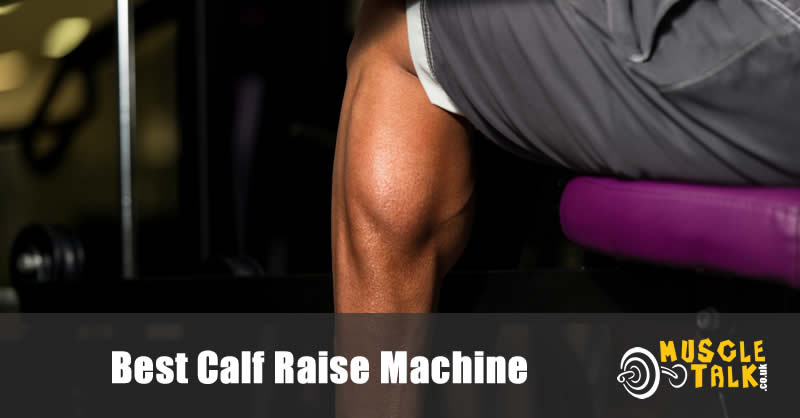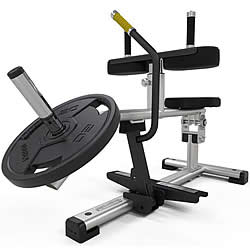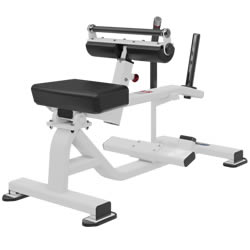Calves are some of the most underestimated and ignored muscles in the human body.
Why? Because most people focus on having a strong upper body, a wide back or building big quads. However, the calves are very important when it comes to athletics and bodybuilding, so you need to give them the attention they deserve next time you go to the gym.

With that being said, you can do something to build powerful calves and the aesthetics that go with a strong pair. Using a decent calf machine can help you build stronger calf muscles and make them pop out when walking, a thing which looks really great in the summer when you wear shorts.
But what calf raise machine is better for your home gym and why?
What if you don’t have much knowledge about fitness equipment or what if you have a limited budget to work with?
If that’s your case then don’t worry. Keep reading this article to expand your understanding when it comes to calf raise machines. You’ll learn more about them, how they work, how to use one and what to look for when you have decided to buy one.
At the same time, this article also provides you with 4 examples of excellent calf raise machines you can find on the market today, so you’re completely covered!
| Image | Product | Score | Price |
|---|---|---|---|
Editor's Choice  | 9.5 | Check on Amazon | |
 |
| 9.3 | Check Best Gym Equipment |
 | 9.2 | Check Best Gym Equipment | |
 | 9 | Check on Amazon |
Contents
Calf Raise Machine Review
Now that you know more about calf raise machines, how they work and how to use one, it’s time to see a few examples of excellent products which help you build stronger calves.
Let’s begin with one of the best overall calf raise machines out there.
The Synergee Seated Calf Raise Machine offers a powerful solution to target and strengthen your calf muscles. With a 550 lbs (250kg) weight capacity, it allows for progressive resistance and efficient calf raises. The machine's compatibility with both 1” and 2” weight plates adds versatility to your workouts.
The design prioritises comfort with a padded seat, adjustable quad cushions, and a textured platform for secure foot placement. Despite some quality concerns mentioned by users, the majority praises its sturdiness and effectiveness. The compact size is suitable for home gyms, and the customer service commitment from Synergee is highlighted. Overall, it proves to be a valuable addition for those serious about calf training.
Summary
The Synergee Seated Calf Raise Machine offers an effective and comfortable solution for calf training at home. While some users reported minor quality concerns and assembly challenges, the majority praise its sturdiness, compatibility, and overall effectiveness in targeting calf muscles. The machine's compact design makes it suitable for home gyms, and Synergee's commitment to customer satisfaction adds value to the purchase.
Calves don’t nearly get the attention they deserve. This EXIGO seated calf machine can help change that. Featuring a comfortable and well padded seat and a ergonomic design, this is the only calf machine you’ll never need.
Summary
One of the challenges with seated calf machines is a correct placement for the thigh pads. Not only are the thigh pads on this machine well placed, they’re extra padded too. That means you can add all the weight and not feel the strain. This is a great choice for anyone who has room for it in their home gym.
With this seated calf raise plate loaded machine, you never have an excuse to skip leg day again. Calves are so often overlooked but when you add this machine to your home gym, you’re taking the first step toward serious legs.
Summary
If you’re looking for a seated calf machine, this is a great choice, provided your workouts don’t go over 100kg. We love the comfortable thigh support and the well-designed weight horn. It would be great if this could support more weight, but it’s probably great for most users.
But what if you have an even smaller budget and you’re looking for a high-quality, easy to use machine you can put in your home gym?
In this case, the Physionics model might be perfect for you as it comes with multiple features and benefits. This is a seated calf raise machine that can be used by all family members and can be assembled in less than an hour.
It is made from thermo-lacquered steel and specially designed to sustain weights of up to 250 kg. This means that you can add multiple heavy weight plates as your calves become stronger and not fear that the machine might give up at some point.
It also features super-comfortable soft padding for the seat and knees. The seat itself is adjustable and the knee bar can also be lowered or lifted upwards, depending on your height and personal preference. It also includes a safety handle which supports the weight to allow you to safely get up when you have finished your routine.
We also love the fact that the padding is easy to clean and maintain over the years.
As for dimensions, it’s about 43 inches in length, 36 inches in height and 23 inches in width. You don’t have to struggle a lot to find a place for it in your living room. It also weighs just 20 kg, so you can move it around without help from a friend.
Summary
Although the Physionics boasts a relatively low price, it is made from very durable materials and it can definitely help you achieve your calf building goals. This seated calf raise machine is an excellent addition to your home gym!
What are Calf Machines and Why Would I Use Them?
A calf raise machine is exactly what the name implies – a machine which helps you work your calves by raising your knees upwards against a certain amount of weight.
Something to give you a decent calf workout is often what is lacking in the average home gym.
The device itself is not complicated. For example, a seated calf raise machine consists of a padded bar which sits on top of your keens and quads. At the feet level, you also have a bar you press into to raise the weight. It works with weight plates or weight stacks and the act of moving the knee bar upwards against the weights helps you develop stronger and bigger calves in the long run.
You would want to use a calf raise machine to ensure that your entire leg, from top to bottom, is properly sculpted and harmoniously developed. It would be a pity to have strong quads, strong hamstrings, and underdeveloped calves.
Keep in mind that your calves define half of your legs from the knee downwards. This part of your body is definitely visible, so why not having strong, sculpted calves which amaze people?
At the same time, having stronger calves can improve your athletic performance in any sport you practice. Whether you’re into boxing, swimming, running or playing basketball, leg strength is paramount for your success. Developing your calves helps you become a more well rounded athlete or bodybuilder.
What to Look for Before You Buy
It’s important to know a few aspects related to calf raise machines, so you can make a better decision based on your preferences and needs. For example:
1. Standing or Seated Machine
These are the two different variants. The seated machine helps you work your calves only and it’s much easier to use. The standing one involves working other body parts, in conjunction with the calves muscles. As you probably already know, standing machines are usually found in commercial gyms and large health and fitness clubs. They are rarely bought by individuals for home use.
If you go for the seated version, the weight is evenly distributed on your gastrocnemius muscles (fancy name for calf muscles). You are basically isolating the calves muscles while you rest your hands on a set of bars in front of you.
A standing calf machine distributes the weight on your entire body – including your back. If you have problems with your spine or have pains in your lower back, a seated machine might be more suitable for you. However, it does put more stress on the calves, so it might be more efficient in working those muscles. Standing machines might also help you work other body parts and some of them allow you to do squats with hundreds of pounds of weight on your shoulders.
If you’ve never used a calf machine, go to a gym and try both models there. See which one feels more natural to you and go with that one. If you are not in the mood for a trip to the gym, it’s recommended to start with the seated calf raise machine until you learn the ropes.
2. Free Weights or Weight Stacks
Your calf raise machine might also come with weight stacks or set to use free weight plates. If you go with free weights, you have more flexibility when it comes to the amount of weight you can put on it. It’s true that you need to buy some weight plates separately, but at least you have the assurance that you might never outgrow your own machine. If you go for free weights, you might need some extra space for them too, especially if you buy very heavy plates.
On the other hand, some calf raise machines come with built-in weight stacks. They rely on a complex system of cables and pulleys, making it easy for you to select the desired weight. This type of machine gives you the advantage of not having to manually remove or add free weights. With that being said, you might outgrow the weight stacks at some point in the future, particularly if you train your calves vigorously for months and years to come.
It’s important to know that machines with weight stacks are most commonly found in gyms and health clubs. They are rarely used in home gyms. Most people buy calf raise machines with free weights because they’re more practical and not as limiting as weight stacks.
3. Supported Load
Some machines, particularly the standing ones, can take up to 363kg of weight because they are made from heavy-duty materials and are designed for professionals. Other machines have a maximum load capacity of 250kg which is still sufficient for most athletes.
If you’re new to calf raise machines, you might not necessarily want to go for a super heavy-duty machine which supports the most weight. Stick with something affordable and compact until you learn the ropes.
4. Space Available
Obviously, space is a consideration for most people and calf raise machines can vary quite a bit.
They come in various sizes and shapes. For example, some of them can measure around 127 cm in length, others can go up to 152 cm or even 178 cm. If you have a relatively small space available to work with, you need to take into account the length of the machine to avoid frustration later on.
Remember that you’ll also need some space to deposit the free weights if you go for a machine with weight plates. If you already have the weight plates then great, you don’t have to worry about this.
5. Materials
When talking about fitness equipment which is capable of supporting loads of several hundred pounds, the materials from which this machine is made is very important.
Generally, you should go for a calf raise machine made from stainless steel which is around 2 inches thick. This solid metallic frame is capable of supporting heavy loads and it gives you more peace of mind while training.
Besides steel, the calf raise machine also needs to have durable and easy-to-clean padding and seat. The place where you put your feet to push yourself upwards must be made from durable rubber which doesn’t get damaged easily. Lastly, these machines tend to be quite heavy, so it would be ideal to get one with small wheels, so you can move it from place to place easier.
How to a Use Seated Calf Raise Machine
Performing calf raises is not complicated at all and the process is very similar, whether you use a seated or standing version.
Let’s begin with the seated calf raise machine:
Seated Calf Raise
Sit on the padded chair and put your thighs and knees under the leg pad. The pad shouldn’t press too hard on your thighs, it should feel comfortable enough. Keep in mind that a seated calf raise machine can be adjusted depending on your height. There is lever under the padded seat which helps you adjust the height of the chair.
Once you have your thighs under the leg pad, put the balls of your feet on top of the footrest and lower your heels as much as possible. If you’re using it for the first time, make sure you choose a small weight until you learn the proper form to do the exercise.
When you’re ready, disengage the weight lock (it’s usually a bar in front of you which you should grab and pull towards you) and begin pressing into the feet rest, lifting your heels upwards. The weight should also rise with your knees and you should feel the work in your calves.
Go for a full upward motion until you have fully flexed your calves. Hold for one or two seconds at the top of the rep and then bring your heels to the original position.
Standing Calf Raise
The process is pretty similar to a standing calf raise machine. The first step is to select an adequate amount of weight, depending on your fitness level and goals. Add or remove weight plates from the rack situated above your shoulders.
When you’re ready, let the shoulder pads rest on your shoulders while you’re having the balls of your feet on the footrest. Your feet should actually be at the edge of the footrest, so you can easily move up and down to lift the weight.
It’s recommended to keep the legs straight, but have your knees bent a little to prevent injury. Lift the weights upwards by bringing your heels as high as possible. Flex your calves and feel the weight of the plates in your legs. Hold for one or two seconds then go as low with your heels as possible. Repeat the exercise to transform your “calves into cows”.
Some Examples of Calf Building Exercise Routines
There are several ways you can build your calves with a calf raise machine.
Most importantly, make sure that you never work your calves when your muscles are cold.
Make sure that you do a proper warm up by using a treadmill for a few minutes, so that your heart rate goes up and your muscles fill with blood.
Whether you choose a seated or standing calf machine, the exercise routine is pretty similar:
- Do one or two warm-up sets on a low weight setting for 10-15 reps. Rest 1-2 minutes in between
- Add more weight and do another 2 sets of 8-10 reps, making sure that your form is correct and you fully extend your calves when lifting the weights. Rest for 2-3 minutes between sets
- Add even more weight and do 2 short sets of 4-6 reps. Rest for 2-3 minutes in between
- Remove some weight and do 2 cool-down sets of 8-10 reps with 1-2 minutes of rest in between
This is an isotonic way of working your calves, meaning that you are actually lengthening and shortening the muscles while contracting them.
However, you can also work your calves isometrically. This means contracting the muscle without lengthening or shortening it. For example:
- Do 2 warm-up sets with low weights as described above
- Add more weight, do 3-4 reps and at the end of each rep when you lift the weight upwards, hold it for 10-12 seconds or even more if possible. You’re still working the muscle because you’re holding the weight up against gravity, but without going up or down (lengthening or shortening the muscle)
- Add more weight and do 1-2 reps, holding for as much as possible at the end of the rep
- Do 1-2 cool down sets and don’t forget to rest in between
Try both these exercise routines and see how it goes. Eventually, you’ll learn to incorporate both isotonic and isometric exercises to maximize your gains and avoid boredom and plateaus.
Again, never train your calves without warming them up. It’s very important to prevent injury!
Conclusion
Building strong calves will improve your athletic performance and really make your legs stand out from the crowd.
Just imagine wearing shorts and displaying your perfectly sculpted calves with pride. These muscles are usually overlooked, so why not stand out with a great set of calves?
These machines help you achieve your goal and live the scenario mentioned above. You just need to be disciplined, eat right and keep working your calves for a few months to see great results.
If you don’t know which one is better for you can’t go far wrong with any of these on our hot list.





